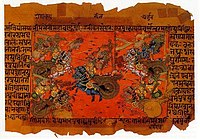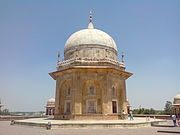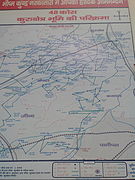Kurukshetra
This article needs additional citations for verification. (February 2015) |
Kurukshetra
Dharmakshetra | |
|---|---|
City | |
UTC+5:30 (IST) | |
| PIN | 136118 |
| Telephone code | 01744 |
| ISO 3166 code | IN-HR |
| Vehicle registration | HR-07 |
| Website | kurukshetra |
Kurukshetra (Hindi pronunciation: [kʊrʊkʃeːtɾə], ⓘ) is a city and administrative headquarters of Kurukshetra district in the Indian state of Haryana. It is also known as Dharmakshetra ("Realm of duty") and as the "Land of the Bhagavad Gita".
Legends

According to the
In the Vedas Kurukshetra is described not as a city but as a region ("
According to the
was impressed with the acts of King Kuru and blessed him with two boons—first, that this land forever will be known as a Holy Land after his name as Kurukshetra (the land of Kuru); second that anyone dying on this land will go to heaven.The land of Kurukshetra was situated between two rivers—the
History
Kurukshetra was conquered by the Mauryan empire in the late 4th century BCE and subsequently became a center of Buddhism and Hinduism. The history of Kurukshetra is little-known in between the collapse of the Mauryans and the rise of the Kushans who conquered the region. After the decline of Kushan power in the region, Kurukshetra became independent only to become conquered by the Gupta empire in the early 4th century CE. Under Gupta rule, Kurukshetra experienced a cultural and religious revival and became a center for Hinduism. After the fall of the Gupta, the Pushyabhuti dynasty ruled over Kurukshetra.[11]
Kurukshetra reached the zenith of its progress during the reign of King Harsha (c. 590–647 CE) during which Chinese scholar Xuanzang visited Thanesar. Civil war broke out when Harsha (of the Pushyabhuti dynasty) died without a successor in 647. A Kashmiri army briefly conquered Kurukshetra in 733 but were unable to establish dominion in the area. In 736, the Tomara dynasty was founded and they took over the region. Around the early 9th century, Kurukshetra lost its independence to Bengal. Mahmud of Ghazni sacked Kurukshetra in 1014 and Muslim raiders sacked it in 1034. Kurukshetra was incorporated into the Delhi Sultanate in 1206. Other than a short moment of independence from the result of a rebellion within the Sultanate in 1240, Kurukshetra was under the control of Delhi until 1388.[11]
Kurukshetra became independent once again after the steep decline of the Delhi Sultanate and the raids of Tamerlane near the region. The Sayyid dynasty incorporated Kurukshetra into their territory though the city likely enjoyed some autonomy. The area was much more firmly controlled under the subsequent Lodi dynasty. Some damages to Kurukshetra and its structures occurred during this period. Kurukshetra became part of the Mughal Empire after Babur quashed a local rebellion in 1526. Under Akbar, Kurukshetra once again became a spiritual center not only for Hindus but also for Sikhs and Muslims.[11]
Between the late 17th and early 18th centuries, Kurukshetra was controlled by the forces of the Maratha Empire until the British took over Delhi in 1803. In 1805, the British took Kurukshetra after defeating the Maratha forces in the Second Anglo-Maratha War, who were controlling the city. Since 1947, Kurukshetra has become a popular spiritual center and has seen much infrastructure, development, and restoration of old structures.[11]
Geography
Kuruksetra is located at around 30° North and 77° East.
Kurukshetra city is surrounded by
Climate
The climate of the district varies as the temperature in summer reaches as high as 47 °C (117 °F), and as low 1 °C (34 °F) in winter, with rains in July and August.
Demography
Religion in Kurukshetra city (2011) [12]
In 2017, the government declared Kurukshetra a holy city and the sale, possession, and consumption of meat are banned within the limits of the Municipal Corporation due to its religious significance.[13]
Transport
Kurukshetra Junction railway station is a junction station at the junction of Delhi–Kalka line and Kurukshetra–Jind branch line.[14] It serves Kurukshetra and Thanesar city.
Tourism
Kurukshetra is an important Hindu pilgrimage destination, and there are several pilgrimage sites surrounding the city. The
Hindu religious sites
- Hindu genealogy registersare kept here.
- Sannihit Sarovar: The pond is believed to be the meeting point of seven sacred Saraswatis. The Sarovar, according to popular belief, contains sacred water. Bathing in the waters of the tank on the day of Amavasya (night of complete darkness) or on the day of an eclipse bestows blessings equivalent to performing the Ashvamedh Yajna.
- Jyotisar: The famous site where Bhagavad Gita was delivered to Arjuna under the tree. The tree of that time is witness to Gita.
- Sthaneshwar Mahadev Temple
Museums
- Kurukshetra Panorama and Science Centre: A mural depiction of the Mahabharata war.
- Dharohar Museum: A museum about the tradition and cultural depiction of Haryana located in Kurukshetra University.
Historical sites
- Mughal era in remembrance of Sufi Saint Sheikh Chehli, believed to be the spiritual teacher of Mughal Prince Dara Shikoh. The Prince's main 'Murshid' or 'Sheikh' (Spiritual Guide), however, is historically known to have been Hazrat Sheikh Mian Mir Sahib, of Lahore,[19] although Sheikh Chehli might have been an additional teacher. Another theory is that the site of the so-called maqbara or tomb. Sheikh Chaheli’s Tomb and the madarasa are associated with the Sufi saint Abdu'r-Rahim alias Aabd-ul-Razak, popularly known as Shaikh Chehli (also pronounced Chilli).[20]
- The Pathar Masjid is built of red sandstone and is known for its fluted minaret.
- Nabha House, a palatial building was constructed by the royal family of Nabha principality.[21]
Wildlife
Educational institutes
- Kurukshetra University
- National Institute of Design
- National Institute of Technology, Kurukshetra
- Shri Krishna AYUSH University
- University Institute of Engineering and Technology, Kurukshetra University
- State Institute of Advance Studies in Teacher Education, Kurukshetra[22]
- Govt. Polytechnic, Umri
- National Institute of Electronics & Information Technology, Kurukshetra[23]
Politics
- Nayab Singh Saini is the current Member of Parliament of 17th Lok Sabha for Kurukshetra.[24] Before him Raj Kumar Saini was the Member of Parliament of 16th Lok Sabha.
District administration
- The district. He is assisted by a number of officers belonging to Haryana Civil Service and other Haryana state services.
- The Superintendent of Police, an officer belonging to the Indian Police Service, is responsible for maintaining Law & Order and related issues in the district. He is assisted by the officers of the Haryana Police Service and other Haryana Police officials.
- The Deputy Conservator of Forests, an officer belonging to the Indian Forest Service, is responsible for the management of the Forests, Environment, and Wildlife in the district. He is assisted by the officers of the Haryana Forest Service and other Haryana Forest officials and Haryana Wildlife officials.
- Sectoral development is looked after by the district head/officer of each development department such as PWD, Health, Education, Agriculture, Animal Husbandry, Statistics, etc. These officers are from various Haryana state services.
- are other towns in the district with significant populations.
In popular art
Notable people
- Nayab Singh Saini, Member of Parliament of Kurukshetra
- Dr. Pawan Saini, doctor, academician, social activist and former MLA of Ladwa
- Raj Kumar Saini, former Member of Parliament from Kurukshetra of 16th Lok Sabha
- Sports Minister of Haryana
- Kailasho Devi Saini, politician and former Member of Parliament
- Surinder Kaur, Hockey player and member of the national field hockey team
- Rohit Sardana, journalist, anchor and media personality
- Sanjay Chaudhary, HUM Foundation, Social Activist
Gallery
-
The statue of Arjun at the Arjun Chowk
-
Brahma Sarovar
-
Bhishma Kund
-
Sannahit Sarovar
-
Sheikh Chilli Tomb
-
Sheikh Chilli Maqbara.
-
Map depicting all the 48 kos parikrama sites displayed at Ban Ganga/Bhishma Kund
-
Sudarshan Chakra Chowk near NIT
-
Bronze Chariot with Lord Krishna and Arjuna in Kurukshetra
References
- ^ "Report of the Commissioner for linguistic minorities: 52nd report (July 2014 to June 2015)" (PDF). National Commission of Linguistic Minorities, India. Commissioner for Linguistic Minorities, Ministry of Minority Affairs, Government of India. pp. 85–86. Archived from the original (PDF) on 15 November 2016. Retrieved 24 March 2019.
- ^ IANS (28 January 2010). "Haryana grants second language status to Punjabi". Hindustan Times. Archived from the original on 5 November 2018. Retrieved 24 March 2019.
- ^ "Kurukshetra (India)". Encyclopædia Britannica. Archived from the original on 10 August 2014. Retrieved 9 August 2014.
- ^ Agarwal, Vishal: Is There Vedic Evidence for the Indo-Aryan Immigration to India? Archived 28 May 2008 at the Wayback Machine
- ^ Pletcher 2010, p. 63.
- ^ Witzel 1995, p. 6.
- ^ a b c d Witzel 1995.
- ^ B. Kölver, ed. (1997). Recht, Staat und Verwaltung im klassischen Indien [Law, State and Administration in Classical India] (in German). München: R. Oldenbourg. pp. 27–52.
- ^ a b c d Samuel 2010.
- ^ Hiltebeitel 2002.
- ^ ISBN 1-884964-04-4.
- ^ "Kurukshetra Population 2021". Archived from the original on 19 December 2022. Retrieved 19 January 2022.
- ^ "Haryana bans meat in holy towns of Kurukshetra, Pehowa". The Indian Express. 25 August 2012. Archived from the original on 9 April 2024. Retrieved 31 March 2013.
- ^ "KKDE/Kurukshetra Junction Railway Station". India Rail Info. Archived from the original on 13 April 2021. Retrieved 29 August 2014.
- ^ "Archived copy". Archived from the original on 25 June 2016. Retrieved 30 May 2016.
{{cite web}}: CS1 maint: archived copy as title (link) - ^ Service, Tribune News. "K'shetra village renamed after Mahabharata's Abhimanyu". Tribuneindia News Service. Archived from the original on 9 April 2024. Retrieved 29 December 2019.
- ^ "Bhagavad-Gita: Chapter". bhagavad-gita.org. Archived from the original on 2 September 2022. Retrieved 2 September 2022.
- ^ Aggarwal, Chandni. "Brahma Sarovar". The Times of India. Archived from the original on 29 September 2019. Retrieved 3 September 2019.
- ^ Lahore Gazetteer, 1887, p. 203
- ^ "Sheikh Chaheli's Tomb | Places of Interest | Kurukshetra | Destinations | Haryana Tourism Corporation Limited". Haryana Tourism Corporation. Haryana Government. Archived from the original on 5 January 2021. Retrieved 26 January 2021.
- ^ "Nabha House | Places of Interest | Kurukshetra | Destinations | Haryana Tourism Corporation Limited". Haryana Tourism Corporation. Archived from the original on 26 July 2021. Retrieved 26 January 2021.
- ^ "Archived copy". Archived from the original on 19 July 2023. Retrieved 19 July 2023.
{{cite web}}: CS1 maint: archived copy as title (link) - ^ "Archived copy". Archived from the original on 19 July 2023. Retrieved 19 July 2023.
{{cite web}}: CS1 maint: archived copy as title (link) - ^ "Nayab Singh(Bharatiya Janata Party(BJP)):Constituency- KURUKSHETRA(HARYANA) - Affidavit Information of Candidate". myneta.info. Archived from the original on 28 June 2021. Retrieved 1 September 2020.
- ISBN 978-81-7201-798-9.
Sources
- Hiltebeitel, Alf (2002), Hinduism. In: Joseph Kitagawa, "The Religious Traditions of Asia: Religion, History, and Culture", Routledge, ISBN 9781136875977, archivedfrom the original on 11 January 2023, retrieved 2 September 2022
- Pletcher, Kenneth (2010), The History of India, The Rosen Publishing Group, ISBN 9781615301225, archivedfrom the original on 9 April 2024, retrieved 2 September 2022
- Samuel, Geoffrey (2010), The Origins of Yoga and Tantra. Indic Religions to the Thirteenth Century, Cambridge University Press
- Witzel, Michael (1990), "On Indian Historical Writing" (PDF), Journal of the Japanese Association for South Asian Studies, 2: 1–57, archived (PDF) from the original on 8 December 2021, retrieved 2 September 2022
- Witzel, Michael (1995), "Early Sanskritization: Origin and Development of the Kuru state" (PDF), EJVS, 1 (4), archived from the original (PDF) on 11 June 2007
External links
- Official website
- Kurukshetra on the Tourism department website of the Haryana Government













